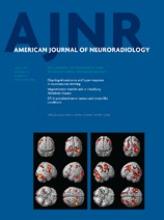Index by author
Chong, J.
- Expedited PublicationYou have accessClopidogrel Resistance Is Associated with Thromboembolic Complications in Patients Undergoing Neurovascular StentingJ.T. Fifi, C. Brockington, J. Narang, W. Leesch, S.L. Ewing, H. Bennet, A. Berenstein and J. ChongAmerican Journal of Neuroradiology April 2013, 34 (4) 716-720; DOI: https://doi.org/10.3174/ajnr.A3405
Chuang, K.-S.
- Head and Neck ImagingYou have accessPrediction of Nodal Metastasis in Head and Neck Cancer Using a 3T MRI ADC MapM.-C. Lee, H.-Y. Tsai, K.-S. Chuang, C.-K. Liu and M.-K. ChenAmerican Journal of Neuroradiology April 2013, 34 (4) 864-869; DOI: https://doi.org/10.3174/ajnr.A3281
Chung, E.-C.
- Pediatric NeuroimagingYou have accessAssessment of Follow-Up Sonography and Clinical Improvement among Infants with Congenital Muscular TorticollisH.-J. Park, S.S. Kim, S.-Y. Lee, Y.-T. Lee, K. Yoon, E.-C. Chung, M.-H. Rho and H.-J. KwagAmerican Journal of Neuroradiology April 2013, 34 (4) 890-894; DOI: https://doi.org/10.3174/ajnr.A3299
Chung, G.H.
- NeurointerventionOpen AccessPredictors of Functional Outcome after Emergency Carotid Artery Stenting and Intra-Arterial Thrombolysis for Treatment of Acute Stroke Associated with Obstruction of the Proximal Internal Carotid Artery and Tandem Downstream OcclusionH.S. Kwak, S.B. Hwang, G.Y. Jin, D.S. Hippe and G.H. ChungAmerican Journal of Neuroradiology April 2013, 34 (4) 841-846; DOI: https://doi.org/10.3174/ajnr.A3304
Churilov, L.
- FELLOWS' JOURNAL CLUBExpedited PublicationYou have accessClopidogrel Hyper-Response and Bleeding Risk in Neurointerventional ProceduresC. Goh, L. Churilov, P. Mitchell, R. Dowling and B. YanAmerican Journal of Neuroradiology April 2013, 34 (4) 721-726; DOI: https://doi.org/10.3174/ajnr.A3418
Patients may respond to antiplatelet medication in 2 ways: resistance leading to higher incidence of ischemic events and hyper-response resulting in bleeds. Here, 47 patients treated with clopidogrel were tested for P2Y12 receptor-mediated platelet inhibition. Clopidogrel hyper-response was more common in patients with major (n=10) than in those with minor bleeds. Of 7 patients defined as hyper-responders, 43% had major bleeding complications. Thus, hyper-response to clopidogrel is associated with increased risk of major hemorrhage. (See the related article by Comin and Kallmes.)
Cohen, S.M.
- Technical NoteYou have accessRecurrent Laryngopyocele: CT-Guided Hookwire Localization for Re-Excision SurgeryA.R. Gafton, S.M. Cohen, J.D. Eastwood, M.K. Dang and J.K. HoangAmerican Journal of Neuroradiology April 2013, 34 (4) E39-E42; DOI: https://doi.org/10.3174/ajnr.A2810
Comin, J.
- Patient SafetyYou have accessPlatelet-Function Testing in Patients Undergoing Neurovascular Procedures: Caught between a Rock and a Hard PlaceJ. Comin and D.F. KallmesAmerican Journal of Neuroradiology April 2013, 34 (4) 730-734; DOI: https://doi.org/10.3174/ajnr.A3440
Connors, J.J.
- EditorialsYou have accessMultisociety Consensus Quality Improvement Guidelines for Intra-Arterial Catheter-Directed Treatment of Acute Ischemic Stroke: Implications for Neuroradiology and Stroke CentersJ.J. Connors and C.M. BlackAmerican Journal of Neuroradiology April 2013, 34 (4) 697-699; DOI: https://doi.org/10.3174/ajnr.A3520
Coulthard, A.
- BrainOpen AccessCorrelation of MRI-Derived Apparent Diffusion Coefficients in Newly Diagnosed Gliomas with [18F]-Fluoro-L-Dopa PET: What Are We Really Measuring with Minimum ADC?S. Rose, M. Fay, P. Thomas, P. Bourgeat, N. Dowson, O. Salvado, Y. Gal, A. Coulthard and S. CrozierAmerican Journal of Neuroradiology April 2013, 34 (4) 758-764; DOI: https://doi.org/10.3174/ajnr.A3315
Crandall, B.M.
- EDITOR'S CHOICENeurointerventionYou have accessDiagnostic Yield of Catheter Angiography in Patients with Subarachnoid Hemorrhage and Negative Initial Noninvasive Neurovascular ExaminationsJ.E. Delgado Almandoz, B.M. Crandall, J.L. Fease, J.M. Scholz, R.E. Anderson, Y. Kadkhodayan and D.E. TubmanAmerican Journal of Neuroradiology April 2013, 34 (4) 833-839; DOI: https://doi.org/10.3174/ajnr.A3291
These authors explored the diagnostic yield of DSA in patients with SAH and previously negative CTA or MRA. A total of 55 patients who presented with diffuse SAH, perimesencephalic SAH, or sulcal SAH received CTA (n= 47) or MRA (n= 8). Despite normal findings on CTA or MRA, DSA showed vascular lesions in 11% of patients with diffuse SAH and in 1 patient with sulcal SAH. The investigators concluded that DSA is a valuable tool in patients with diffuse or sulcal SAH in whom previous noninvasive examinations are negative.








